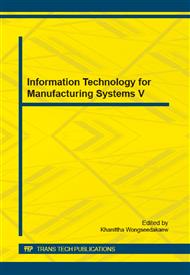[1]
Timo Ojala and Matti Pietikainen, Multiresolution Gray-Scale and Rotation Invariant Texture Classification with Local Binary Patterns, IEEE TRANSACTIONS ON PATTERN ANALYSIS AND MACHINE INTELLIGENCE, VOL. 24, NO. 7, pages 971-986, JULY (2002).
DOI: 10.1109/tpami.2002.1017623
Google Scholar
[2]
Tam´as Szir´anyi and M´arton Csapodi, Texture Classification and Segmentation by Cellular Neural Networks Using Genetic Learning, COMPUTER VISION AND IMAGE UNDERSTANDING Vol. 71, No. 3, September, p.255–270, (1998).
DOI: 10.1006/cviu.1997.0646
Google Scholar
[3]
K.J. Dana and S.K. Nayar. Correlation model for 3d texture. In Proceedings of ICCV99: IEEE International Conference on Computer Vision, pages 1061–1067, (1999).
DOI: 10.1109/iccv.1999.790389
Google Scholar
[4]
Junyu Dong and Mike Chantler, Capture and Synthesis of 3D Surface Texture, International Journal of Computer Vision Volume 62, 177-194, (2005).
DOI: 10.1023/b:visi.0000046595.00028.f1
Google Scholar
[5]
M. Chantler, M. Petrou, A. Penirsche, M. Schmidt, and G. McGunnigle. Classifying Surface Texture while Simultaneously Estimating Illumination Direction. International Journal of Computer Vision, 62(1): 83–96, (2005).
DOI: 10.1007/s11263-005-4636-3
Google Scholar
[6]
J. Wu and M. J. Chantler. Combining gradient and albedo data for rotation invariant classification of 3d surface texture. In ICCV '03: Proceedings of the Ninth IEEE International Conference on Computer Vision, page 848, Washington, DC, USA, 2003. IEEE Computer Society.
DOI: 10.1109/iccv.2003.1238437
Google Scholar
[7]
W. Sweldens, The Lifting Scheme: A Custom-Design Construction of Biorthogonal Wavelets Industrial Mathematics Initiative, Tech. Rep. 1994: 7, Dept. Math., Univ. South Carolina, Columbia, (1994).
Google Scholar
[8]
R. L. Claypoole, G. M. Davis, W. Sweldens, and R. G. Baraniuk, Nonlinear wavelet transforms for image coding via lifting, IEEE Trans. Image Processing, vol. 12, p.1449–1459, Dec. (2003).
DOI: 10.1109/tip.2003.817237
Google Scholar
[9]
Wenpeng Ding, Feng Wu, Xiaolin Wu, Shipeng Li and Houqiang Li, Adaptive Directional Lifting-Based Wavelet Transform for Image Coding, IEEE Transactions on Image Processing, vol. 16, no. 2, February (2007).
DOI: 10.1109/tip.2006.888341
Google Scholar
[10]
Chuo-Ling Chang, Arian Maleki, and Bernd Girod, Adaptive Wavelet Transform for Image Compression via Directional Quincunx Lifting, Multimedia Signal Processing, (2005).
DOI: 10.1109/mmsp.2005.248564
Google Scholar
[11]
A. Gouze, M. Antonini, M. Barlaud, and B. Macq, Design of signal adapted multidimensional lifting scheme for lossy coding, IEEE Trans. Image Processing, vol. 13, p.1589–1603, Dec. (2004).
DOI: 10.1109/tip.2004.837556
Google Scholar
[12]
PhoTex database. Texture lab, Heriot-Watt University, Edinburgh, UK. Available on-line at http: /www. cee. hw. ac. uk/texturelab/database/photex.
Google Scholar


